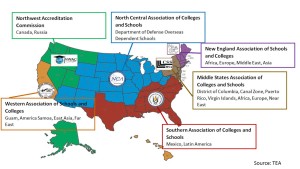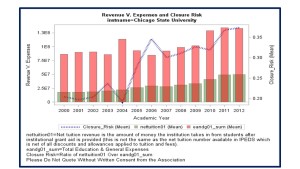It seems that the American society does not to have much choices when dealing with cheating conducted by selected segments in the higher education industry. The society completely depends on the regulator’s willingness to take appropriate actions toward the lemons. Though, it has been identified by many who they are, it takes the regulator a tremendous amount of time to deal with the problems. The business model of some of the organizations do not gear toward helping the students, but to find ways to extract the public money which often left the students in debts which some of them have to carry the burdens for the rest of their life. It is stunning how ignorance this country has been toward students being cheated from left and right. Only one law maker has consistently voiced the concern and try to change the course! Where are the rests? Making the matter worst, the accrediting agencies that supposed to keep players in the line, found to be part of the problems. Who else should we trust?
Is Cheating Becoming a Normal Game?
On December 14th, 2015, the Association has written and published an article i.e., ESCC. In this article the importance of checking financial accountability was stressed. Today we again learned why such an accountability is urgently needed. One problem after another found in the industry. While the regulator tries to deal with academic accountability, and now it has to deal with another bigger problem related to the institutions’ financial integrity, fraud and cheating. Corinthian and American Career Institute, or ACI are just two cases that show the tip of the iceberg. It did not just happen only at for-profit organizations. There are many more out there. As it is currently, the regulator just do not have enough man-power to conduct the financial accountability jobs on more than 6000 organizations. The fact of the matter was that it, the regulator just started to establish a unit within its organization to conduct such efforts starting in February, 2016 after the Association again and again urged it to do so.
Next…Ruling On College Accrediting Agencies
On April 22, 2016, Democratic Policy and Communications Committee (DPCC), known before as DPC, Democratic Policy Committee wrote a letter to DOE Secretary to take more firm measures to various accrediting agencies. We all may know the infamous case on the Corinthian College, a for-profit education institution. When it collapsed, it was an accredited higher education institution in the US. One may ask the question how could this thing happen? An accredited institution went bankrupt without any prior warning from the accrediting agencies that supposedly to protect the interests of the American society? The Association has written an article on July 03, 2015 to raise the issue. Though a bit late, this is one of the reasons that motivates the Senate Democrats to write the letter to the DOE Secretary. We, at the Association are glad that finally the US lawmakers do something and other institution confirmed the Association’s observation on May 5th, 2016. There are a couple things that one can learn from this case:
- All involved parties are reactive instead of proactive.
- Colleges’ accreditors may not have done their job optimally.
- No consequences in place for a sub-par quality work. Therefore, there should be an accreditor agency or agencies to conduct compliance tests on all current accrediting agencies’ work.
- Accreditation policies, and processes and (using Mr. Gray’s words, the accrediting agencies, have they own methods and criteria) may have been out-dated and they need to be reevaluated, rewritten and to be streamlined with the American society’s concerns.
Despite the fact that…
We, at the Association know what is going to happen to most of US colleges many years ago. In particular, to those who have not applied data-driven in their decision making process. We have tried hard to share this new knowledge to the college administrators. It pretty sad, that for whatever reasons, decision makers are less eager to make changes in their organization. Making a change (singular) is hard. Therefore, more likely making changes (plural) are even impossible. Especially, if the changes will touch sensitive issues such as the campus culture. In the free-market world, there are rewards and unfortunately the opposite of them as well. As the resources get squeezed, then one will expect there will be more unfavorable impacts will occur on higher institutions such as what has just happened at Chicago State University. The first step that these institutions can do in the new sea of competitions and limited resources is to have a team of IRI analytics, data scientist, data miners or big data experts. The traditionalists may look at the past, but the IRI analytics enables one to see the future and beyond.
Chicago State University: Recent Staff Layoff
We recently learned that on Friday (04/29/2016) Chicago State University has laid off 1/3 of its staff due to a budget shortfall. About three years ago, the Association has shared its research finding which shows the potential financial risk facing higher education institutions in the US. Below is the CSU’s financial performance as measured by institutional revenue V. expenditure metrics. The dotted blue line shows the closure risk facing the institution over time.
Performance Based Funding and Its Impacts On US Colleges
When resources are getting smaller, one will expect many changes will happen in an industry or an organization. This is exactly what has happened in the US higher education industry. Three years ago, the Association has reminded all players to be prepared for what are coming their ways. Perhaps only a handful is listening or even believe what the Association has tried to convey. An obvious adjustment that has been taken place on college funding at the state level is the new state funding model known by many as Performance Based Funding. In this model the pie will be divided based on college rankings. More and more states in the country have applied such an approach to allocate the budget among state colleges. Most states will use several measures and then use these yardsticks to rank colleges or universities in the state. Institution with higher rank will be awarded more money than those in the lower one. The impacts are significant, especially on institutions which are ranked lower and got their budget cut. Staff layout or salary freeze are the most common impacts of such application of this new funding. How can an institution survive the new game of state funding?
Making the Future of US Higher Ed Stronger Through A Better College Financial Accountability
We also learned today that DOE has launched a new enforcement unit which will closely monitor financial accountability among US colleges who are benefited from the federal government funding programs in Higher Ed. This development will increase the pressures for college decision makers to ensure that both academic and financial accountability are in-check. The Association has, in the past suggested that the US needs such an accountability for making sure Pareto Optimality, or at least Pareto Improvement is achieved in the industry. Financial burdens caused by operational inefficiency will only make the country, the tax payers,the student borrowers and their family to be worse-off. Therefore, the BAU ways to conduct business in the industry are slowly, but surely dying. In contrast, the new paradigms which the Association has proposed and written in its Blog few years ago will surely be one of the best alternatives to overcome such challenges. This new ruling will not in anyway weaken the US Higher Ed, rather to make it better in the long-run. However, Colleges have to make strategic decisions to move forward, and not backward. Given these new developments, the Association will share its expertise to colleges who need it. Do not wait any longer, just contact us.
Business Model For-profit Education Companies?
Today we learned that one of the leading public companies in the for-profit education industry will sell its business to a group of investors. Again, many years ago the Association has predicted that this possibility may occur, and that we learned today it has happened. Note that if this can happen to for-profit education institutions, one can also make a parallel prediction what is going to happen to private, small, and non-state owned education institutions, unless certain strategic actions are taken. The Association has written in its Blog many months ago that the US education industry is experiencing phenomenal structural changes. As the regulator puts more breaks, one may see more mergers, take-overs or college closures in the future.
Time Is Right to Apply IRI Paradigm in the College Decision Making Process?
Note: This Blog has been updated on February 10, 2016!
Making a change is hard, and not everyone will embrace the call for a change easily. The Association has predicted accurately that this sort of changes will cause tensions as it has been shown recently in one of the US campuses. There will always be two sides of the story. But, strategic decisions have to be made based on past and present data as well as possible regulator’s policy changes in the future. Colleges have to use different yard sticks, than what and how they have been applied in the past when admitting college applicants. There will always be a conflict between the Admissions and Recruitment Office (who wants to bring as many students to campus as possible. Perhaps, including under-prepared students) and the Student Success Office (who wants to retain as many students as possible). Lower student retention rates will surely affect negatively the institution’s score card (and lower operational budget, as a result). The article said that the University President has to make a decision to cut the students off who may not be able to make it. Had the institution applies the IRI paradigm in the admissions process, we are very sure this unnecessary tension could ever happen. IRI will help the decision makers to identify high risk students prior admitting them. Unfortunate the process of identifying them was done after their got admitted and enrolled.
New Strategies to Increase College Student Enrollment?
Many colleges are experiencing financial challenges because of decreasing student enrollment. The Association has completed and shared the studies based on real data on such possible future trends. The results of these studies have pointed out increasing pressures for many colleges to deal with their enrollment numbers. Especially for Liberal Arts Colleges and other “private institutions” to be able to attract enough students. We have learned that several colleges plan to lower their tuition as reported in the media. If the elasticity of demand for their services is greater than one, then lowering the tuition may lead to enrollment increases. Otherwise, it is just a wishful strategy. In other words, lowering tuition will not always guarantee for enrollment to increase.


